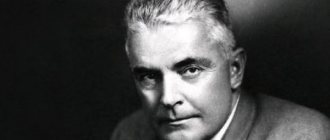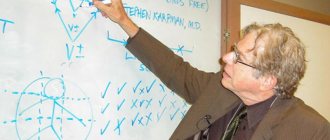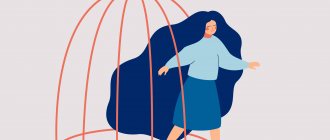Reflex
There is no need to describe the entire mechanism of reflex activity of biological organisms. This was done superbly by I.P. Pavlov. Let us consider only some aspects of reflex activity.
All vital activity of higher animals is carried out through reflex activity, that is, through the somatic mind of the biological basis of life. More than a reflex, a bioorganism - the biological basis of life - is not capable of producing. Moreover: the reflex is the only mechanism of the biological basis of higher animals in relationships with the surrounding reality. There are no other mechanisms. Everything we do: we walk, eat, love, hate, think, talk, create - everything, absolutely everything, is carried out and reflected in the central nervous system in the form of reflex arcs.
A reflex is a single response of a biological basis to an external or internal influence, aimed at the survival of the individual, acting independently of human consciousness.
A reflex is always the performance by some muscle, or group of muscles, of a single, highly specific task. The only processes carried out without the participation of muscles - the processes of thinking - are still carried out according to the principle of a reflex mechanism.
A reflex is a structural unit of the somatic mind, which is a cycle of actions:
· Reception by sensory organ receptors of influence from the stimulus,
the occurrence of excitation in receptors,
· transmission of excitation in the form of an electrical impulse (signal) to the nerve pathways and the passage of the signal along the nerve pathways,
· signal analysis and synthesis of response information in the central nervous system,
· the passage of the response signal along the nerve pathways to the muscles that perform the reflexes,
· muscular response of one of the biologically based organs.
The morphological basis of reflex activity is the central nervous system, led by the brain.
The human brain works with 100% reliability. This corresponds to the dynamic principle of existence. Even if we assume that the brain works, say, with 99% reliability, then, according to the dynamic principle of existence, through natural selection, a person must die, because after 99 correct decisions in life-threatening situations, the brain will definitely give one wrong, fatal decision , which means a death sentence for the individual and then the species. Or it will turn 99% into 100%, and the species will continue to exist.
It would not be a mistake to compare the human brain with a computer (cybernetics arose on the basis of data from studying the functioning of the brain). Both the brain and the computer work based on the same patterns. The human brain, from this position, is a perfect biological computer.
The “program” for loading the human brain with information is the system of innate reflexes. In response to the input information, the human innate reflex system always produces an adequate response to the input information. And this program also cannot contain errors according to the same dynamic principle of existence with its mechanism of natural selection.
What is the somatic mind - only a system of innate reflexes?
- Not really:
A person comes into this world with a program of innate actions embedded in it in certain standard situations - a system of innate reflexes.
INNATE (conditioned) REFLEX is a response of an innate reaction of a biological basis to an influence from the outside (from the surrounding world) or from within the body on the innate reflexogenic zone of a given reflex, aimed at the survival of the individual and acting independently of the person’s consciousness.
Congenital reflexes have in the central nervous system ready-made, genetically determined, laid down even before the birth of the organism, nerve pathways along which the signals that excite the reflex go.
But innate reflexes occupy only a very small part of the human brain. The rest of the brain is a “blank slate” on which all information, all of a person’s life experience is recorded in the form of conditioned reflexes.
CONDITIONED (acquired) REFLEX is an innate response of a biological basis to the influence of a previously indifferent stimulus, developed in the process of life on the basis of an innate reflex, aimed at the survival of the individual and acting independently of human consciousness. Simply put, a conditioned reflex is the same unconditioned reflex, but triggered by a new stimulus.
As it becomes clear from the definition, the neural pathways along which the signals of the conditioned reflex pass are also innate, since they represent the neural pathways of the basic innate reflex. New, how a conditioned reflex differs from an innate one - the method of excitation:
$1· the innate reflex is excited by the action of a stimulus on the innate reflexogenic zone of the innate reflex,
$1· the conditioned reflex is excited by the action of any previously indifferent stimulus on any of the sense organs, but not on the innate reflexogenic zone of the innate reflex.
Conditioned (not innate) reflexes are formed only thanks to innate reflexes. This happens in the following way: the reflexogenic zone of the innate reflex is affected by the stimulus. An innate reflex is triggered. At the same time (or a little earlier), another stimulus (no matter what) is applied to any other receptor zone that is not associated with this reflex. At this moment, in the cerebral cortex, according to I.P. Pavlov, a “nervous circuit” is established between the two emerging foci of excitation (a new stimulus and an innate reflex): the conditioned reflex is ready. The receptor zone of the new stimulus becomes the reflexogenic zone of the newly emerged conditioned reflex.
The impact is always made either on the reflexogenic zone of the innate or on the reflexogenic zone of the non-congenital reflex. But the body's response is always innate, since any conditioned reflex is always based on an unconditioned reflex. Unlike the innate reflex, with its ready-made innate, unchangeable nerve connections, the conditioned reflex forms temporary conditioned nerve connections in the central nervous system. The term “temporary” here does not mean “for a while”, but: “not innate”, “changeable”. Nervous connections, even temporary ones, once formed, never disappear.
“Somatic mind” is the entire system of reflexes: both innate and non-innate. All reflexes are the “thoughts” with which our biological basis—the human body—thinks. Ultimately, as a result of reflex activity, we receive actions of the body that are adequate to the input information and aimed at its survival. This system is impeccable and operates flawlessly throughout the entire history of the existence of higher biological organisms.
Man is the highest evolutionary link in the animal world on Earth. The mechanism of conditioned-unconditioned reflex activity had been perfected for many millions of years. Just like any other mechanism in the human body, the reflex mechanism works with 100% reliability. This is a mandatory requirement of the dynamic principle of existence. Nature has not determined any other mechanism for the survival of the biological basis of man than the mechanism of reflex activity. All scientific data, all human historical experience points to this.
From the standpoint of the dualism of the origin of man - the presence of soul and body - the reflex activity of the human body acquires a completely different role in human life than it was assigned before. Previously it was believed (and is still believed!) that human consciousness allows him to regulate reflex activity. In classical psychology, there is the concept of “will” - a person’s conscious regulation of his behavior, expressed in the ability to see and overcome internal and external obstacles (read: reflexes), on the path of purposeful actions and actions.
Through an effort of will, a person can thus supposedly extinguish some reflexes and stimulate others. For example, to overcome fear, overcome fatigue, in order to achieve some higher goals (both fear and fatigue are manifestations of the instinct of self-preservation).
The deepest misconception. A person cannot consciously manipulate reflexes. One effort of thought, desire, etc. is clearly not enough to stop such a powerful process as the execution of a reflex.
The reflex system of the somatic mind is a biological basis survival system. Therefore, any conscious actions of a person that contradict the execution of reflexes will be assessed by the somatic mind as actions aimed at one degree or another of self-destruction. And, naturally, they will be stopped immediately. Here the principle of “primacy of the reflex” is manifested - the principle of the existence of the biological basis of life: any action of the biological basis is, first of all, subordinated to the dynamic principle of existence. Anything else is swept away by the evolution of biological life.
From here it becomes clear that no effort of “will”, thought, desire, etc., directed against the work of the somatic mind, is capable of stopping the processes of reflex activity. A reflex can only be stopped by another reflex, a “stronger” one, which has a greater survival value for the biological basis. To stop the action of one reflex, another, stronger reflex must be excited
Reaction speed training
There are several well-known rules for developing reaction speeds:
You should learn to anticipate the enemy's actions
The difference between a student and a master is that the student reacts to the very movement of the attacker, and the master sees the preparatory actions or even the intentions of the enemy. The master sees 2 phases in every movement:
- phase preceding movement (subtle change in posture, redistribution of muscle tension, change in breathing)
- movement phase (when a blow is struck or a defensive or attacking action is performed). Practicing the skill of anticipating enemy actions is carried out exclusively with a partner. It is almost impossible to master this technique on your own.
Training conditions should be changed
Practice of actions should be carried out at different paces, at different speeds, with a change of environment (in the hall, in the forest, on the sand, in urban conditions, etc.), with different partners, etc.
Actions must be practiced until they become instinctive. It is important to ensure that the technique is performed correctly. Actions must be performed equally well and technically in any conditions.
You should train at maximum speed
As part of your workout, you can change the speed from as slow as possible to as fast as possible. However, the biodynamic structure of movements of the total volume of all movements performed should be close to the maximum speed.
Remember to relax
Relaxation is understood as a state of inner peace, when the ability to perceive the maximum amount of information from the outside is combined with absolute readiness to perform an action.
This condition includes physical, psychological and emotional self-control and requires long-term work, primarily with oneself.
Nothing should distract you. There should be no unnecessary thoughts and emotions in your head. Masters call this state “Here and Now.” In addition, there should be no external manifestations of the upcoming actions.
Visualization should be used
It is recommended to find time to do visualization exercises or Autogenic training.
By imagining yourself performing this or that action flawlessly, you can significantly improve the quality of the results from physical training.
It is especially important to learn to imagine yourself in real combat. This practice allows you to achieve the desired result in a short time and translate visualized images into reality.
Don't give away your intentions
The enemy should not be able to “calculate” your actions.
It is necessary to ensure that actions are spontaneous and unexpected.
Make sure you don't clench your fists before throwing a punch or take a certain stance. The blow must be, as Musashi Miyamoto wrote in the Book of Five Rings “...from the void”... “without a plan... without an idea...”
Spontaneity and suddenness of movements are what will allow you to hide your intentions from the enemy.
Correct breathing technique must be used.
You should not hold your breath during a fight. This prevents the muscles from relaxing and also reduces the speed and force of the blows.
In addition, from the point of view of neurophysiology, any loud shouts, such as “Kiai,” extinguish the impulse.
It is necessary to learn how to strike, perform techniques and perform defensive actions, both while inhaling and exhaling.
By the way, this principle is one of the main ones in the practice of the Russian martial art “IZVOR”.
You should maintain good physical shape
The speed of motor reactions, coordination, speed and strength qualities, endurance and flexibility largely depend on the physical form of the fighter. Therefore, general physical training is the most important element of training in any type of martial arts.
Literature
- Skoromets A. A., Skoromets A. P., Skoromets T. A. Propaedeutics of clinical neurology. St. Petersburg: Politekhnika, 2004
- Chief editor member Academy of Medical Sciences of the USSR Kositsky G.I., “Human Physiology.” Ed. "Medicine", 1985.
- Dictionary of physiological terms / resp. ed. Gazenko O.G. - M.: “Nauka”, 1987. - 32,000 copies.
- Fundamental and clinical physiology: Textbook for students of higher educational institutions / ed. Kamkin A.G., Kamensky A.A. - M.: Publishing Center "Academy", 2004. - 1072 p. — 5,000 copies. — ISBN 5-7695-1675-5.
- Nozdrachev A.D., Barannikova I.A., Batuev A.S.
and others. Physiology of the nervous, muscular and sensory systems // General course of human and animal physiology. In 2 books: Textbook. for biol. and honey specialist. universities - M.: "Higher School", 1991. - T. 1. - 512 p. — 48,000 copies. — ISBN 5-06-000650-6. - Sergeev B.F.
Stages of evolution of intelligence. - M.: Nauka, 1986. - 192 p.
Species specificity
Unconditioned reflexes (specific) are present in both humans and animals. It should be understood that such reactions will be the same in all representatives of the same species. An example is a turtle. All species of these amphibians retract their heads and limbs into their shell when danger arises. And all the hedgehogs jump and make a hissing sound. In addition, you should know that not all unconditioned reflexes occur at the same time. These reactions vary with age and season. For example, the breeding season or the motor and sucking actions that appear in an 18-week fetus. Thus, unconditioned reactions are a kind of development for conditioned reflexes in humans and animals. For example, as cubs grow older, they transition to the category of synthetic complexes. They increase the body's adaptability to external environmental conditions.








